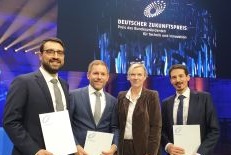Content
“Digital light” for cars and augmented reality: DPMA President congratulates the winners of the Deutscher Zukunftspreispreis

From left to right: Federal Minister Cem Özdemir, Dr Hermann Oppermann, Dr Norwin von Malm, Stefan Grötsch, Federal President Frank-Walter
Federal President recognises research team for highly innovative LED lights – first practical use in car headlights – DPMA President: promising technology that opens up many new possibilities

New possibilities through ‘digital light’: close-up of the EVIYOS 2.0 light source
Press release of 27 November 2024
Munich. The President of the German Patent and Trade Mark Office, Eva Schewior, congratulated the development team from asm-OSRAM and the Fraunhofer IZM on receiving the Deutscher Zukunftspreis award. “We would like to sincerely congratulate the winning team on this outstanding award,” the DPMA President said. “With their digital light, the team has developed a promising technology that opens up many new possibilities. When used in headlights, it can help avoid many dangerous situations in the dark.” Today (27 November) Federal President Frank-Walter Steinmeier honoured the team at the awards ceremony in Berlin.
For their innovative light source for headlights, Dr Norwin von Malm, Stefan Grötsch (ams-OSRAM International GmbH, Regensburg) and Dr Hermann Oppermann (Fraunhofer IZM, Berlin) use more than 25,000 small LEDs in a matrix of 320x80 points instead of fewer but bigger LEDs. Combined with a special lens this creates a headlight that can be compared to a video projector. Each LED can be controlled individually, so that the spatial distribution of the light can be directed and optimally adapted to the given situation. It is also possible to project pictograms like snowflakes onto the street – an interesting addition to projections on the windshield. Other possible applications for the “digital light”, as their developers call it, are the use as a virtual monitor in AR glasses or as lightening source for an optical fiber bundle.
The following teams were also nominated for the Deutscher Zukunftspreis:
Prof Björn Ommer (Ludwig-Maximilians-Universität München) and Dr Anna Lukasson-Herzig (nyris GmbH) were nominated with their project “Democratisation of generative AI – Stable Diffusion from development to practice”. With “Stable Diffusion”, Prof Ommer’s team has developed a compact and efficient generative AI system that is freely available and can be applied in countless ways, especially by start-ups. nyris GmbH uses “Stable Diffusion” for the search for spare parts. Complex technical installations consist of thousands of parts. If a part is defect and needs to be replaced, this leads to a search for the type name or order number, which is not always printed on the part itself. One solution would be to start an image search using a photo of the part. However, not every spare part is included as an actual photo in a spare parts catalogue – often there are only technical drawings (CAD data).
This is where AI comes into play: it generates photorealistic images from the technical drawings. Those images can in turn be used to train an image search engine, which can then identify a part in seconds using a photo of it.

The team recommended by the DPMA and President Eva Schewior
Dr Konrad Schraml, Dr Caspar Leendertz (Infineon Technologies AG, Munich) and Prof Thomas Basler (TU Chemnitz) have developed a semiconductor module that enables significantly higher current flows and 90% fewer switching losses without an increase in size. This means the module can also save energy in environments with high current flows – e.g. in electric trains, heavy goods vehicle traffic and in power grids, which are increasingly being fed renewable energies. The energy-saving module combines multiple innovations: unlike conventional modules, the energy-saving chip does not use silicon, but silicon carbide and thus boasts a much higher rupture strength and energy efficiency. However, this new material also has some drawbacks: it is very hard, brittle, expands with heat and is also more expensive than silicon. The fact that the new module is still more economic is due to the innovative, material-saving chip design. An innovative process and the use of copper as contact metal compensate for the challenging material properties. The team was nominated for the Deutscher Zukunftspreis award by the DPMA.
“This year in particular, the Deutscher Zukunftspreis proves to be a beacon in tough economic times”, said DPMA President Schewior. “The broad range and the high quality of the nominated innovations show that Germany is still a highly productive place of innovation.”
The Deutscher Zukunftspreis award – the Federal President’s Award for Technology and Innovation – comes with a prize money of 250,000 euros. The award ceremony with the Federal President in Berlin was also livestreamed at zdf.de and at deutscher-zukunftspreis.de. A taping was broadcast by the German TV channel ZDF as part of their regular programming.
The German Patent and Trade Mark Office
Inventiveness and creativity need effective protection. The DPMA is the German centre of expertise for all intellectual property rights – patents, utility models, trade marks and designs. As the largest national patent office in Europe and the fifth largest national patent office in the world, our office stands for the future of Germany as a country of inventors in a globalised economy. Its staff of just under 2,800 at three locations – Munich, Jena and Berlin – provide services to inventors and companies. They implement federal innovation strategies and develop the national, European and international protection systems.
Pictures: Deutscher Zukunftspreis- Bildschoen, Ansgar Pudenz
Last updated: 27 November 2024

Not only protecting innovations
Social Media